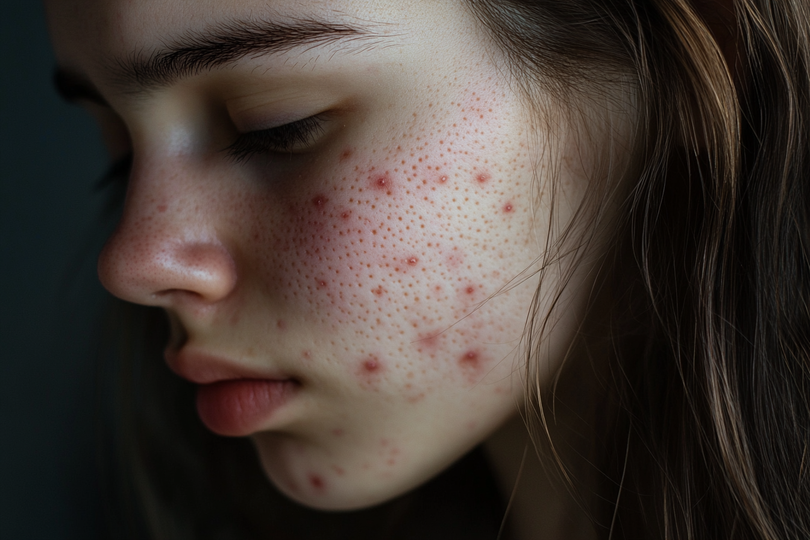Understanding Different Types of Acne
Acne is a skin condition that comes in various forms, each requiring a different treatment approach. Understanding the type of acne you have is the first step toward effective management. Here are the most common types of acne:
- Blackheads (Open Comedones): These small, dark spots appear when pores become clogged with oil and dead skin cells. The black color comes from the oxidation of the trapped material when exposed to air. Blackheads are usually not inflamed and can be treated with topical retinoids or over-the-counter products containing salicylic acid.
- Whiteheads (Closed Comedones): Similar to blackheads, whiteheads occur when pores are clogged, but in this case, the pore remains closed. They appear as small, white bumps and are treated similarly to blackheads, often with retinoids to unclog pores.
- Papules: These are small, red bumps caused by inflammation. They occur when bacteria in the skin infect clogged pores, leading to redness and irritation. Papules typically require a combination of topical retinoids and anti-inflammatory agents like benzoyl peroxide or antibiotics.
- Pustules: Pustules are inflamed, red lesions with a white or yellow center, filled with pus. Like papules, they are caused by bacterial infections in clogged pores. Treatment often involves topical retinoids and benzoyl peroxide, with the potential addition of antibiotics for more severe cases.
- Nodules: Nodules are large, painful lumps beneath the surface of the skin. They are more severe than papules or pustules and can lead to scarring if not treated properly. For nodules, oral antibiotics or even oral isotretinoin may be required.
- Cysts: Cysts are the most severe type of acne, consisting of large, pus-filled lumps beneath the skin. They are painful, can cause scarring, and often require oral isotretinoin or other specialist treatments.
By identifying the type of acne you’re dealing with, you can ensure that you’re following the most effective treatment plan.
How Does TeleTest Approach Acne Treatment?
Tretinoin
Tretinoin, also known as retinoic acid, stands out as the most effective retinoid, boasting proven anti-aging and acne-fighting properties. However, its availability is limited to prescription use, making it absent from over-the-counter cosmeceuticals. In contrast, retinol, a common ingredient in cosmeceutical products, is approximately 10 times less potent than tretinoin. To put this into perspective, a 0.25% retinol concentration is considered equivalent in efficacy to 0.025% tretinoin. It's worth noting that the maximum recommended concentration of retinol in cosmetic products is capped at 0.3%, balancing potential benefits with safety considerations.
Duration of Treatment: The Foundation of Success
Consistency is essential when it comes to effective acne treatment. At TeleTest, we prioritize starting with the lowest strength medication to minimize side effects. Our approach typically involves maintaining a treatment routine for 8-12 weeks before increasing the strength or switching medications. This allows doctors to assess the full effectiveness of the treatment.
Managing Mild Acne: Starting Simple
For individuals dealing with mild acne, which usually consists of blackheads and whiteheads, we recommend beginning with topical retinoids. These medications not only treat existing acne but also prevent future breakouts.
Common Treatment Options:
- Tretinoin 0.025%-0.05%: Apply once daily at bedtime.
- Tazorac (Arazlo) 0.045%: Apply once daily at bedtime.
For long-term maintenance, a topical retinoid like Tretinoin can be used daily to keep acne in check.
Tackling Mild to Moderate Acne: Combining Treatments
When acne progresses to mild-moderate levels, which includes inflammatory papules and pustules (red bumps), a combination of a topical retinoid and benzoyl peroxide (BPO) is the next step.
Treatment Examples:
- TactuPump: Apply once daily at bedtime.
- Epiduo: Apply once daily at bedtime.
Maintenance Options: Either continue using a topical retinoid or use a combination of a topical retinoid with BPO.
Managing Moderate Acne: A Step Up
For those with moderate acne, including red bumps and firmer nodules, we escalate the treatment with gel-based antibiotics and BPO for morning use, followed by a retinoid in the evening.
Treatment Examples:
- Benzaclin (Clindamycin with BPO): Apply in the morning.
- Tretinoin or Adapalene: Apply at bedtime.
If the acne includes nodules, an oral antibiotic such as Doxycycline may be added for up to 90 days. This helps reduce inflammation and prevents bacterial resistance.
Addressing Severe Acne: Specialist Referral
For individuals with severe acne, characterized by numerous nodules, papules, and pustules, we recommend seeing a dermatologist for a prescription of oral isotretinoin. TeleTest physicians do not prescribe isotretinoin, but we can refer patients to specialists who do.
Back Acne: Specific Strategies
Back acne, particularly in moderate cases, is treated with prescription washes and possibly oral antibiotics.
Treatment Examples:
- BPO 10% body wash: Use once daily for 90 days.
- Doxycycline 100mg: Take once daily for 90 days.
Skin Care Routine: Supporting Your Treatment
To complement the pharmaceutical treatments, we recommend a gentle skincare routine. Use a mild, non-comedogenic cleanser to remove excess oil and dirt without irritating the skin.
Counselling: Understanding the Journey
Acne can be a long and frustrating battle. While over-the-counter products may provide temporary relief, the most effective long-term treatments come from prescribed medications, backed by clinical trials and proven to work. At TeleTest, we emphasize this evidence-based approach, ensuring patients are supported at every stage of their treatment.
Disclaimer: This blog post is intended for educational purposes only and should not be taken as medical advice. Always consult your healthcare provider for personal health concerns.
